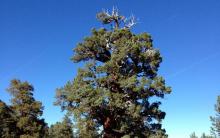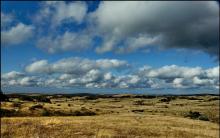"Architectural" plants always attract the eye. In fact, these are ready-made living sculptures created by nature. But the requirements for them are quite high. They should have a graphic silhouette and a sleek appearance throughout the season, and be resistant to diseases, pests and all weather adversities. And if it is easy to choose a candidate for the main role among the arboreal ones, then you will have to tinker with the selection of the tapeworm or the dominant group from the herbaceous ones. We suggest paying close attention to large-leaved perennials.
A place under the sun
Large ones look very harmonious in open areas. hosts . Dense foliage of gigantic size visually makes the plant even more spreading and luxuriant. Often, individual large-leaved hostas are planted on the lawn, in the foreground of an open area, as a decoration for the entrance space. For single plantings, as a rule, sun-tolerant varieties are used. The blue colors are in the lead" Big Daddy" And " Big Mama", in chartreuse-gold - " Sum and Substance" And " Beauty Substance". Other sports (a new form of plant resulting from mutation) from " Sum and Substance", For example, " Lady Isobel Barnett" or " Sum It Up", no less beautiful.

Authors of new varieties often do not know what size their hostas will reach with age. More and more new record holders are appearing: for example, the leaf " Xanadu Empress Wu"in the fifth or sixth year it can reach a meter in length. Of course, large hostas can be planted in groups, but the second plant immediately neutralizes the entire sculptural effect when planted solo.
Both alone and in groups in the bright sun and in the shade, the lushly blooming Telekia is beautiful (Telekia speciosa). A powerful spreading bush can reach a height of about 1.5 m. Large yellow inflorescences - “daisies” - cover it almost entirely for a month at the zenith of summer. Faded baskets need to be pruned, since the plant is sown abundantly. Sturdy, heart-shaped leaves, up to 60 cm long, often interlock with neighboring plants.

Shadow sector
Since the end of the last century, the shady corners of our gardens have been decorated with Rogers (Rogersia) - plants with large dissected leaves. In partial shade and with good drainage, the variety is unusually effective. Rogers pinnate (R. pinnata) "Chocolate Wing s" with chocolate-brown leaves on long (up to 80 cm) petioles. As the foliage grows, it turns bronze, and by mid-summer a one and a half meter peduncle with a white panicle up to 30 cm long rises above it. The compact Rogersia "is no less beautiful. Die Schone", the wide lobes of its bronze leaves are very textured. The variety " Fireworks"The edges of the leaves are slightly reddish, and in combination with pale pink flowers are very elegant. Red-brownish varieties Rogersia podophylla (R. podophylla) "Braunlaub" And " Rotlaub"by eye they are not at all different from each other. Probably, you need to look for ten differences in botanical subtleties or shades of flowers. But who is completely different from other species is this Rogersia concochestanofolia (R. aesculifolia) - the name speaks for itself. Rogersia elderifolia (R. sambucifolia) slightly lower - 70 cm, flowers are white-green.

One of a Kind
Looks unusual under the canopy of trees darmera thyroid (peltiphyllum) (Darmera peltata). Like all clump perennials, it grows well. In the spring, before the leaves appear, against the background of bare ground, its pink-red spherical flowers on a high (50 cm) peduncle are magnificent. In summer, Darmera attracts attention with its succulent round shield leaves with a notched edge on high (75-85 cm) petioles. In this case, individual leaves reach 40 cm in diameter. And in autumn they turn red-orange. Peltiphyllum is also very beautiful in coastal compositions. It can be damaged by return frosts, but quickly restores its shape. Grows well in loose, moist and fairly fertile soils.
Another unique representative of his kind - astilboides lamellar (Astilboides tabularis). Sometimes in garden centers it is found under the old name - Rogersia lamellar. The plant has truly huge, hard, round leaves up to 60 cm in diameter, similar to darmera leaves, but absolutely flat, without a funnel at the petiole. This giant is beautiful in all stages of development, and especially in June - early July, when a creamy-white panicle resembling astilbe appears on a high peduncle. On moist soil in a shady place, a small seedling in two years will turn into a hero, covering a square meter of garden area.











The most beautiful motorcycles in the world
Which sea is the cleanest in the world?
Top 10 Most Expensive Furs
The largest and most luxurious casinos in the world
Knightly orders of Europe XI - XIII centuries